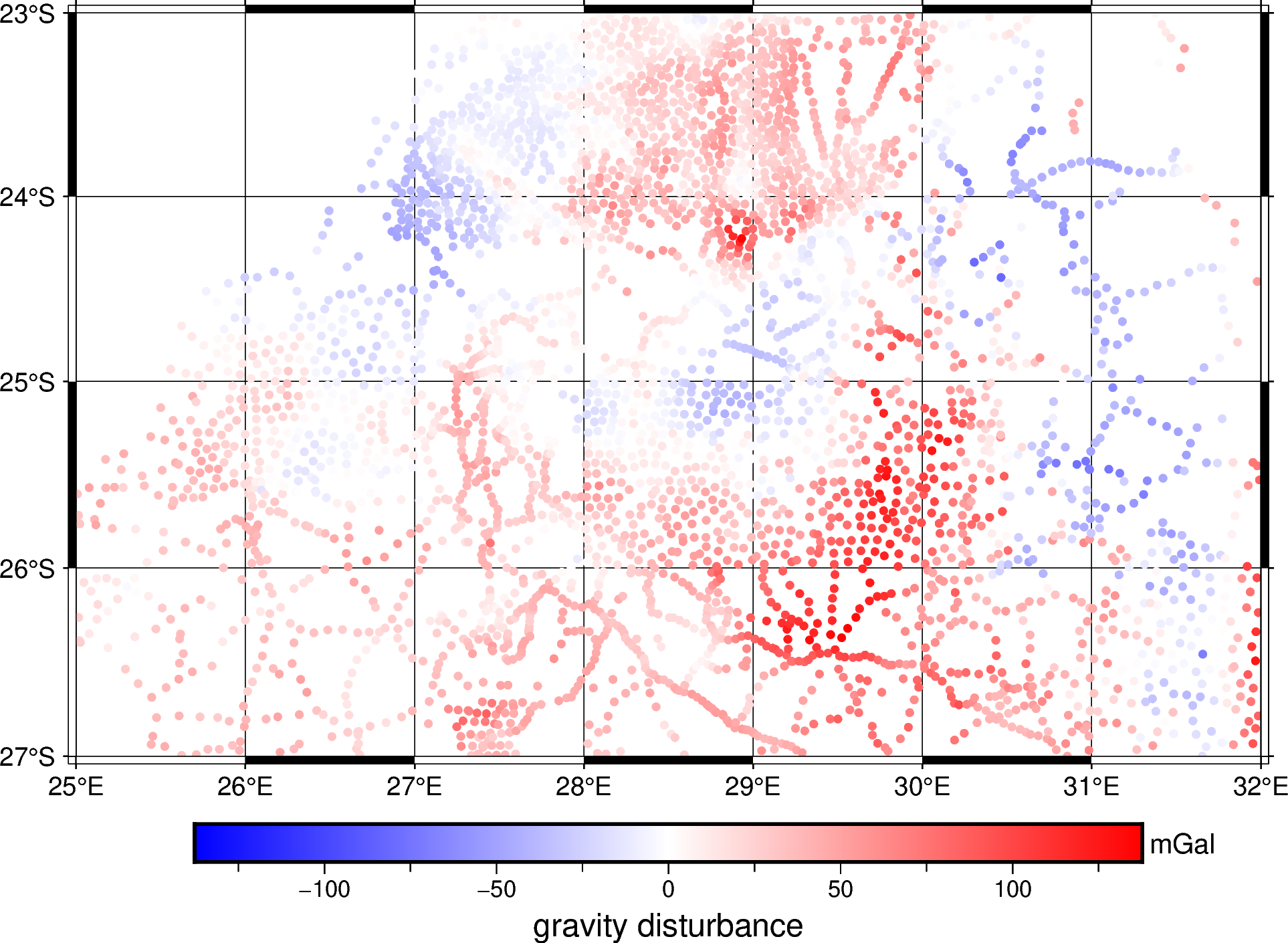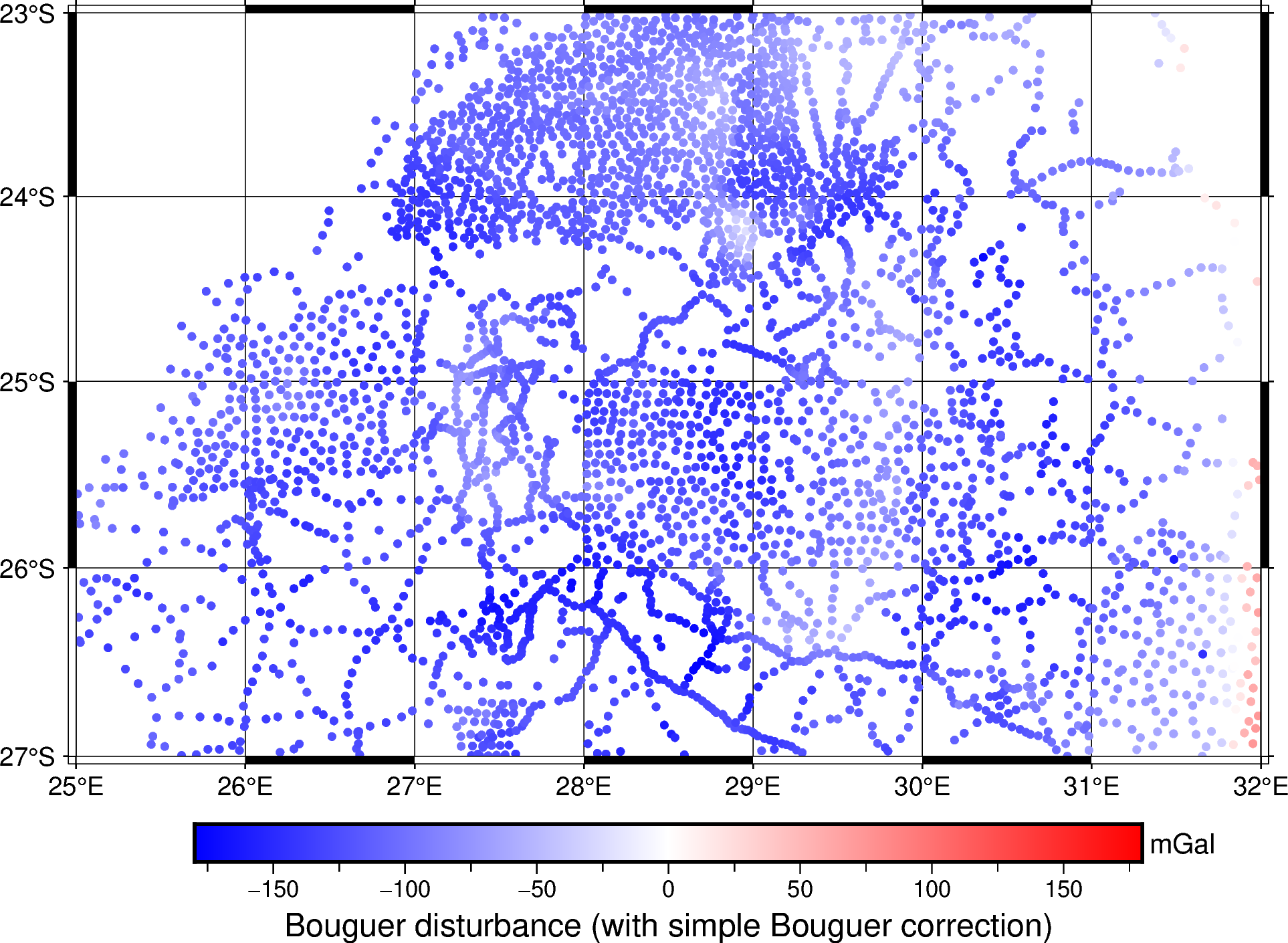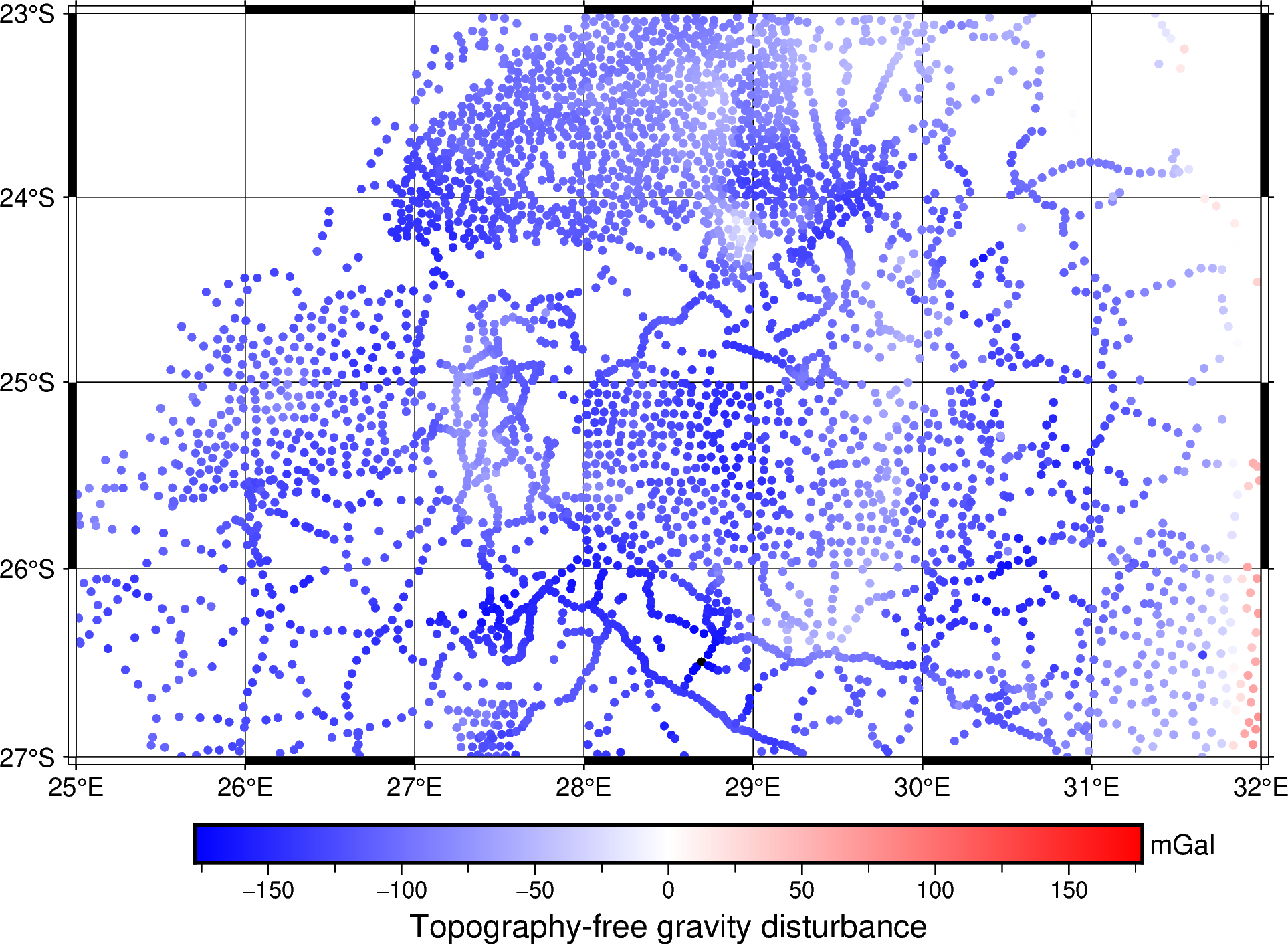Topographic Correction#
Computing the gravity disturbance is usually the first step towards generating a dataset that could provide insight of the structures and bodies that lie beneath Earth surface.
One of the strongest signals present in the gravity disturbances are the gravitational effect of the topography, i.e. every body located above the surface of the reference ellipsoid. Mainly because their proximity to the observation points but also because their density contrast could be considered the same as their own absolute density.
For this reason, geophysicists usually remove the gravitational effect of the topography from the gravity disturbance in a processes called topographic correction. The resulting field is often called Bouguer gravity disturbance or topography-free gravity disturbance.
The simpler way to apply the topographic correction is through the Bouguer correction. It consists in approximating the topographic masses that lay underneath each computation point as an infinite slab of constant density. It has been widely used on ground surveys because it’s easy to compute and because we don’t need any other data than the observation height (the height at which the gravity has been measured). It’s main drawback is it’s accuracy: the approximation might be too simple to accurately reproduce the gravitational effect of the topography present in our region of interest.
On the other hand, we can compute the topographic correction by forward modelling the topographic masses. To do so we will need a 2D grid of the topography, a.k.a. a DEM (digital elevation model). This method produces accurate corrections if the DEM has good resolutions, but its computation is much more expensive.
In the following sections we will explore how we can apply both methods using Harmonica.
Lets start by downloading some gravity data over the Bushveld Igneous Complex in Southern Africa.
import ensaio
import pandas as pd
fname = ensaio.fetch_bushveld_gravity(version=1)
data = pd.read_csv(fname)
data
| longitude | latitude | height_sea_level_m | height_geometric_m | gravity_mgal | gravity_disturbance_mgal | gravity_bouguer_mgal | |
|---|---|---|---|---|---|---|---|
| 0 | 25.01500 | -26.26334 | 1230.2 | 1257.474535 | 978681.38 | 25.081592 | -113.259165 |
| 1 | 25.01932 | -26.38713 | 1297.0 | 1324.574150 | 978669.02 | 24.538158 | -122.662101 |
| 2 | 25.02499 | -26.39667 | 1304.8 | 1332.401322 | 978669.28 | 26.526960 | -121.339321 |
| 3 | 25.04500 | -26.07668 | 1165.2 | 1192.107148 | 978681.08 | 17.954814 | -113.817543 |
| 4 | 25.07668 | -26.35001 | 1262.5 | 1289.971792 | 978665.19 | 12.700307 | -130.460126 |
| ... | ... | ... | ... | ... | ... | ... | ... |
| 3872 | 31.51500 | -23.86333 | 300.5 | 312.710241 | 978776.85 | -4.783965 | -39.543608 |
| 3873 | 31.52499 | -23.30000 | 280.7 | 292.686630 | 978798.55 | 48.012766 | 16.602026 |
| 3874 | 31.54832 | -23.19333 | 245.7 | 257.592670 | 978803.55 | 49.161771 | 22.456674 |
| 3875 | 31.57333 | -23.84833 | 226.8 | 239.199065 | 978808.44 | 5.116904 | -20.419870 |
| 3876 | 31.37500 | -23.00000 | 285.6 | 297.165672 | 978734.77 | 5.186926 | -25.922627 |
3877 rows × 7 columns
And plot it:
import pygmt
import verde as vd
maxabs = vd.maxabs(data.gravity_disturbance_mgal)
fig = pygmt.Figure()
pygmt.makecpt(cmap="polar+h0", series=[-maxabs, maxabs])
fig.plot(
x=data.longitude,
y=data.latitude,
fill=data.gravity_disturbance_mgal,
cmap=True,
style="c3p",
projection="M15c",
frame=['ag', 'WSen'],
)
fig.colorbar(cmap=True, frame=["a50f25", "x+lgravity disturbance", "y+lmGal"])
fig.show()

Bouguer correction#
We can compute the Bouguer correction through the
harmonica.bouguer_correction function.
Because our gravity data has been obtained on the Earth surface, the
height_geometric_m coordinate coincides with the topographic height at each
observation point (referenced above the ellipsoid), so we can pass it as the
topography argument.
import harmonica as hm
bouguer_correction = hm.bouguer_correction(data.height_geometric_m)
Hint
The harmonica.bouguer_correction assigns default values for the
density of the upper crust and the water.
Warning
In case the observations heights were referenced over the geoid (usually marked as above the mean sea level), it’s advisable to convert them to geometric heights by removing the geoid height.
We can now compute the Bouguer disturbance and plot it:
bouguer_disturbance = data.gravity_disturbance_mgal - bouguer_correction
bouguer_disturbance
0 -115.716267
1 -123.772762
2 -122.660359
3 -115.523941
4 -131.736230
...
3872 -39.797741
3873 15.241009
3874 20.319441
3875 -21.665918
3876 -28.086345
Length: 3877, dtype: float64
maxabs = vd.maxabs(bouguer_disturbance)
fig = pygmt.Figure()
pygmt.makecpt(cmap="polar+h0", series=[-maxabs, maxabs])
fig.plot(
x=data.longitude,
y=data.latitude,
fill=bouguer_disturbance,
cmap=True,
style="c3p",
projection="M15c",
frame=['ag', 'WSen'],
)
fig.colorbar(cmap=True, frame=["a50f25", "x+lBouguer disturbance (with simple Bouguer correction)", "y+lmGal"])
fig.show()

Forward modelling the topography#
In order to forward model the topographic masses, we need to build a 3D model made out of simpler geometric bodies. In this case, we are going to use rectangular prisms. Then we will compute the gravitational effect of every prism on each computation point.
To do so, we need a regular grid of the topographic heights (or DEM as in Digital Elevation Model) around the Bushveld Igneous Complex. We can download a global topography grid:
import xarray as xr
fname = ensaio.fetch_southern_africa_topography(version=1)
topography = xr.load_dataarray(fname)
topography
<xarray.DataArray 'topography' (latitude: 1182, longitude: 1371)> Size: 13MB
array([[-5039., -5027., -5014., ..., -3846., -3867., -3873.],
[-5036., -5021., -5007., ..., -3839., -3863., -3872.],
[-5031., -5016., -5001., ..., -3835., -3860., -3870.],
...,
[-2906., -2901., -2884., ..., 173., 134., 118.],
[-2908., -2906., -2888., ..., 132., 119., 118.],
[-2912., -2910., -2894., ..., 122., 120., 128.]])
Coordinates:
* longitude (longitude) float64 11kB 10.92 10.93 10.95 ... 33.72 33.73 33.75
* latitude (latitude) float64 9kB -36.0 -35.98 -35.97 ... -16.33 -16.32
Attributes:
Conventions: CF-1.8
title: Topographic and bathymetric height for Southern Africa ob...
crs: WGS84
source: Downloaded from NOAA website (https://ngdc.noaa.gov/mgg/g...
license: public domain
references: https://doi.org/10.7289/V5C8276M
long_name: topographic height above mean sea level
standard_name: height_above_mean_sea_level
description: height topography/bathymetry referenced to mean sea level
units: m
actual_range: [-5685. 3376.]
noaa_metadata: Conventions: COARDS/CF-1.0\ntitle: ETOPO1_Ice_g_gmt4.grd\...And then crop it to a slightly larger region than the gravity observations:
region = vd.get_region((data.longitude, data.latitude))
region_pad = vd.pad_region(region, pad=1)
topography = topography.sel(
longitude=slice(region_pad[0], region_pad[1]),
latitude=slice(region_pad[2], region_pad[3]),
)
topography
<xarray.DataArray 'topography' (latitude: 360, longitude: 539)> Size: 2MB
array([[ 1408., 1403., 1398., ..., -1300., -1316., -1336.],
[ 1413., 1406., 1400., ..., -1292., -1305., -1319.],
[ 1415., 1409., 1402., ..., -1284., -1295., -1306.],
...,
[ 970., 972., 973., ..., 121., 120., 122.],
[ 970., 973., 974., ..., 121., 120., 123.],
[ 967., 970., 974., ..., 122., 122., 123.]])
Coordinates:
* longitude (longitude) float64 4kB 24.02 24.03 24.05 ... 32.95 32.97 32.98
* latitude (latitude) float64 3kB -28.0 -27.98 -27.97 ... -22.03 -22.02
Attributes:
Conventions: CF-1.8
title: Topographic and bathymetric height for Southern Africa ob...
crs: WGS84
source: Downloaded from NOAA website (https://ngdc.noaa.gov/mgg/g...
license: public domain
references: https://doi.org/10.7289/V5C8276M
long_name: topographic height above mean sea level
standard_name: height_above_mean_sea_level
description: height topography/bathymetry referenced to mean sea level
units: m
actual_range: [-5685. 3376.]
noaa_metadata: Conventions: COARDS/CF-1.0\ntitle: ETOPO1_Ice_g_gmt4.grd\...And project it to plain coordinates using pyproj and verde.
We start by defining a Mercator projection:
import pyproj
projection = pyproj.Proj(proj="merc", lat_ts=topography.latitude.values.mean())
And project the grid using verde.project_grid:
topography_proj = vd.project_grid(topography, projection, method="nearest")
topography_proj
<xarray.DataArray 'topography' (northing: 360, easting: 539)> Size: 2MB
array([[ 1408. , 1403. , 1396.5, ..., -1300. , -1316. , -1336. ],
[ 1409.5, 1409.5, 1399. , ..., -1292. , -1305. , -1319. ],
[ 1412. , 1412. , 1399.5, ..., -1276. , -1295. , -1306. ],
...,
[ 971. , 971. , 973. , ..., 122.5, 120. , 122. ],
[ 970. , 970. , 974.5, ..., 122.5, 121. , 123. ],
[ 970. , 970. , 974.5, ..., 122.5, 121. , 123. ]])
Coordinates:
* easting (easting) float64 4kB 2.424e+06 2.426e+06 ... 3.328e+06 3.329e+06
* northing (northing) float64 3kB -2.928e+06 -2.926e+06 ... -2.265e+06
Attributes:
metadata: Generated by Chain(steps=[('mean',\n BlockReduce(...Tip
Using the "nearest" method makes the projection process faster than
using the "linear" one.
Now we can create a 3D model of the topographic masses using a layer of
rectangular prisms. We can use the harmonica.prism_layer function to
build it.
We also need to assign density values to each prism in the layer.
For every prism above the ellipsoid we will set the density of the upper crust
(2670 kg/m3), while for each prism below it we will assign the
density contrast equal to the density of the water (1040 kg/m3) minus
the density of the upper crust.
import numpy as np
density = np.where(topography_proj >= 0, 2670, 1040 - 2670)
prisms = hm.prism_layer(
(topography_proj.easting, topography_proj.northing),
surface=topography_proj,
reference=0,
properties={"density": density},
)
prisms
<xarray.Dataset> Size: 5MB
Dimensions: (northing: 360, easting: 539)
Coordinates:
* easting (easting) float64 4kB 2.424e+06 2.426e+06 ... 3.328e+06 3.329e+06
* northing (northing) float64 3kB -2.928e+06 -2.926e+06 ... -2.265e+06
top (northing, easting) float64 2MB 1.408e+03 1.403e+03 ... 123.0
bottom (northing, easting) float64 2MB 0.0 0.0 0.0 0.0 ... 0.0 0.0 0.0
Data variables:
density (northing, easting) int64 2MB 2670 2670 2670 ... 2670 2670 2670
Attributes:
coords_units: meters
properties_units: SINow we need to compute the gravitational effect of these prisms on every
observation point. We can do it through the
harmonica.DatasetAccessorPrismLayer.gravity method. But the coordinates
of the observation points must be also projected.
# Project the coordinates of the observation points
easting, northing = projection(data.longitude.values, data.latitude.values)
coordinates = (easting, northing, data.height_geometric_m)
# Compute the terrain effect
terrain_effect = prisms.prism_layer.gravity(coordinates, field="g_z")
Finally, we can compute the topography-free gravity disturbance:
topo_free_disturbance = data.gravity_disturbance_mgal - terrain_effect
And plot it:
maxabs = vd.maxabs(topo_free_disturbance)
fig = pygmt.Figure()
pygmt.makecpt(cmap="polar+h0", series=[-maxabs, maxabs])
fig.plot(
x=data.longitude,
y=data.latitude,
fill=topo_free_disturbance,
cmap=True,
style="c3p",
projection="M15c",
frame=['ag', 'WSen'],
)
fig.colorbar(cmap=True, frame=["a50f25", "x+lTopography-free gravity disturbance", "y+lmGal"])
fig.show()
